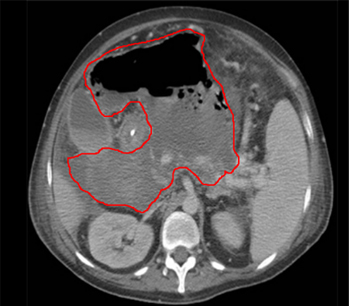Summary
Definition
History and exam
Key diagnostic factors
- presence of risk factors
- fever or hypothermia
- abdominal pain
- rectal tenderness and fullness
Other diagnostic factors
- tachycardia
- change in bowel habits/abnormal bowel function
- prolonged ileus
- anorexia/lack of appetite
- nausea and vomiting
- palpable mass
- signs of sepsis
- pre-operative corticosteroid use
Diagnostic investigations
Investigations to consider
- serum CRP
- serum erythrocyte sedimentation rate (ESR)
- Gram stain of abscess fluid
- serum glucose
- abdominal ultrasound
- abdominal MRI scan
Treatment algorithm
Contributors
Authors
Laura Kreiner, MD, FACS
Assistant Professor of Surgery
MetroHealth Medical Center
Case Western Reserve University School of Medicine
Cleveland
OH
Disclosures
LK declares that she has no competing interests.
Acknowledgements
Dr Laura Kreiner would like to gratefully acknowledge Dr Ali F. Mallat, Dr Lena M. Napolitano, and Dr Lillian Kao, previous contributors to this topic.
Disclosures
AFM declares that he has no competing interests. LMN has been a member of the speakers' bureau and consultant for Merck, Pfizer, Schering-Plough, Ortho-McNeil, Wyeth, and Astellas Pharma. LK declares that she has no competing interests.
Peer reviewers
James T. Lee, MD, PhD, FACS, FIDSA, FSHEA
Professor of Surgery (retired)
University of Minnesota
Saint Paul
MN
Disclosures
JTL declares that he has no competing interests.
Jeffrey A. Claridge, MD, MS, FACS
Director of Research
Division of Trauma, Burns and Critical Care
Assistant Professor
Department of Surgery
MetroHealth Medical Center
Case Western Reserve University School of Medicine
Cleveland
OH
Disclosures
JAC declares that he has no competing interests.
Matthew Falagas, MD, MSc, DSc
Director
Alfa Institute of Biomedical Sciences
Marousi
Athens
Greece
Disclosures
MF declares that he has no competing interests.
Use of this content is subject to our disclaimer
